1997 PONTIAC PONTIAC key
[x] Cancel search: keyPage 158 of 419
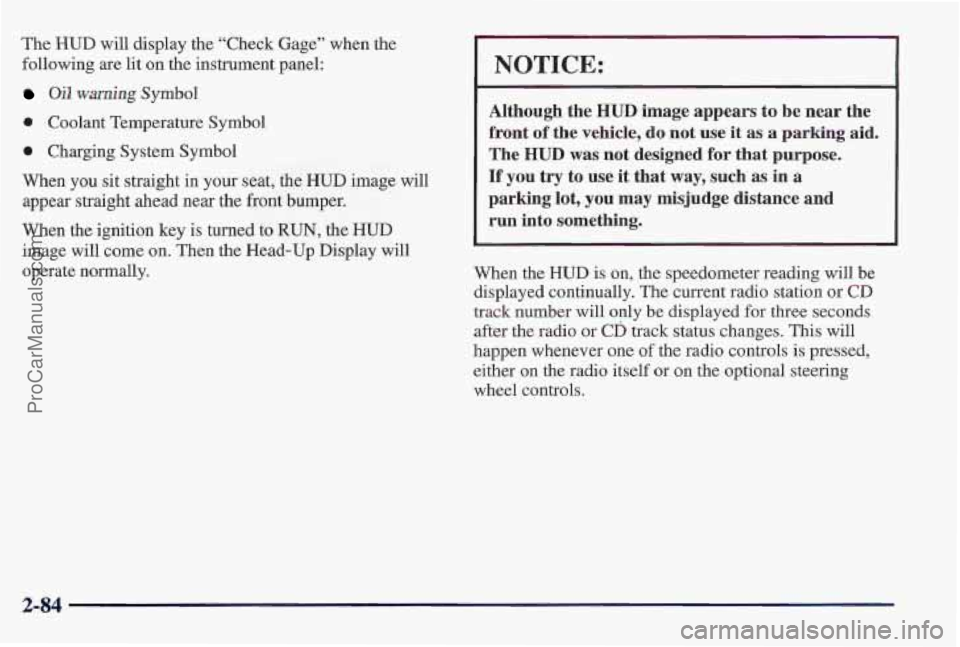
The HUD will display the “Check Gage” when the
following are lit on the instrument panel:
Oil warning Symbol
0 Coolant Temperature Symbol
0 Charging System Symbol
When you sit straight in your seat, the HUD image will
appear straight ahead near the front bumper.
When
the ignition key is turned to RUN, the HUD
image will come on. Then the Head-Up Display will
operate normally.
NOTICE:
Although the HUD image appears to be near the
front
of the vehicle, do not use it as a parking aid.
The
HUD was not designed for that purpose.
If you try to use it that way, such as in a
parking lot, you may misjudge distance and
run into something.
When the HUD is on, the speedometer reading will be
displayed continually. The current radio station or
CD
track number will only be displayed for three seconds
after the radio or
CD track status changes. This will
happen whenever one
of the radio controls is pressed,
either on the radio itself or on the optional steering
wheel controls.
...... ............. ... ...... .... . ... 2-84 L ., .5 e--..% _I...-,. I. .. .: . ’ ., , ,. ,.-. - .... ., .. _. .. .. . ,. .
ProCarManuals.com
Page 197 of 419
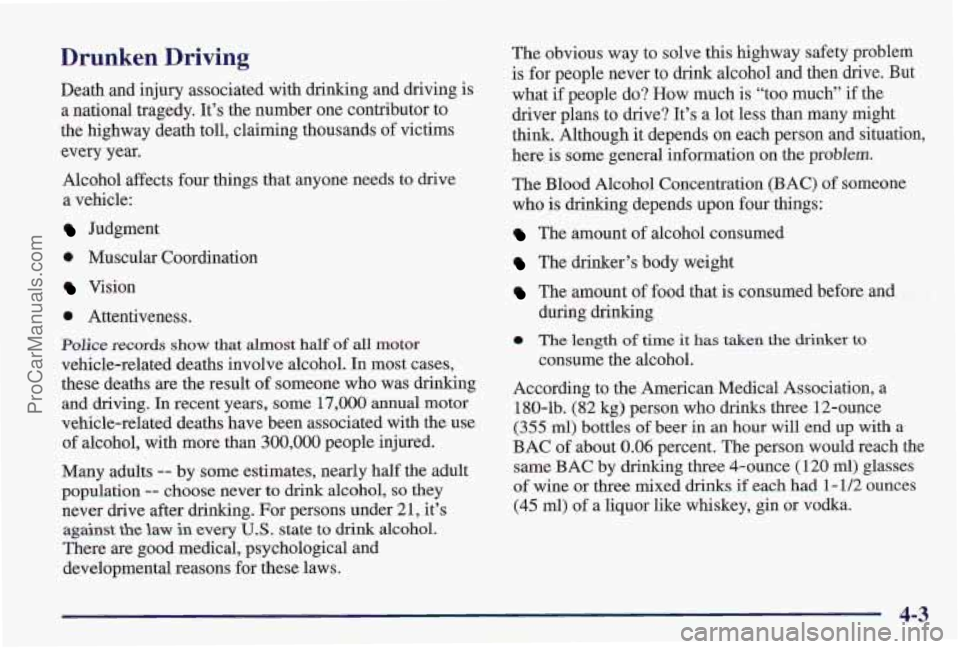
Drunken Driving
Death and injury associated with drinking and driving is
a national tragedy. It’s the number one contributor to
the highway death toll, claiming thousands of victims
every year.
Alcohol affects four things that anyone needs to drive
a vehicle:
Judgment
0 Muscular Coordination
Vision
0 Attentiveness.
Police records show that almost half of all motor
vehicle-related deaths involve alcohol. In most cases,
these deaths
are the result of someone who was drinking
and driving. In recent years, some
17,000 annual motor
vehicle-related deaths have been associated with the use
of alcohol, with more than
300,000 people injured.
Many adults
-- by some estimates, nearly half the adult
population
-- choose never to drink alcohol, so they
never drive after drinking.
For persons under 2 1, it’s
against the law in every US. state to drink alcohol.
There are good medical, psychological and
developmental reasons for these laws. The
obvious way to solve this highway safety problem
is for people never to drink alcohol and then drive. But
what if people do? How much is “too much”
if the
driver plans to drive? It’s
a lot less than many might
think. Although it depends on each person and situation,
here is some general information on the problem.
The Blood Alcohol Concentration (BAC) of someone
who is drinking depends upon four things:
The amount of alcohol consumed
The drinker’s body weight
The amount of food that is consumed before and
during drinking
0 The length of time it has taken the drinker to
consume the alcohol.
According to the American Medical Association,
a
180-lb. (82 kg) person who drinks three 12-ounce
(355 ml) bottles of beer in an hour will end up with a
BAC of about 0.06 percent. The person would reach the
same BAC by drinking three 4-ounce
( 120 ml) glasses
of wine or three mixed drinks if each had 1-112 ounces
(45 ml) of a liquor like whiskey, gin or vodka.
ProCarManuals.com
Page 236 of 419
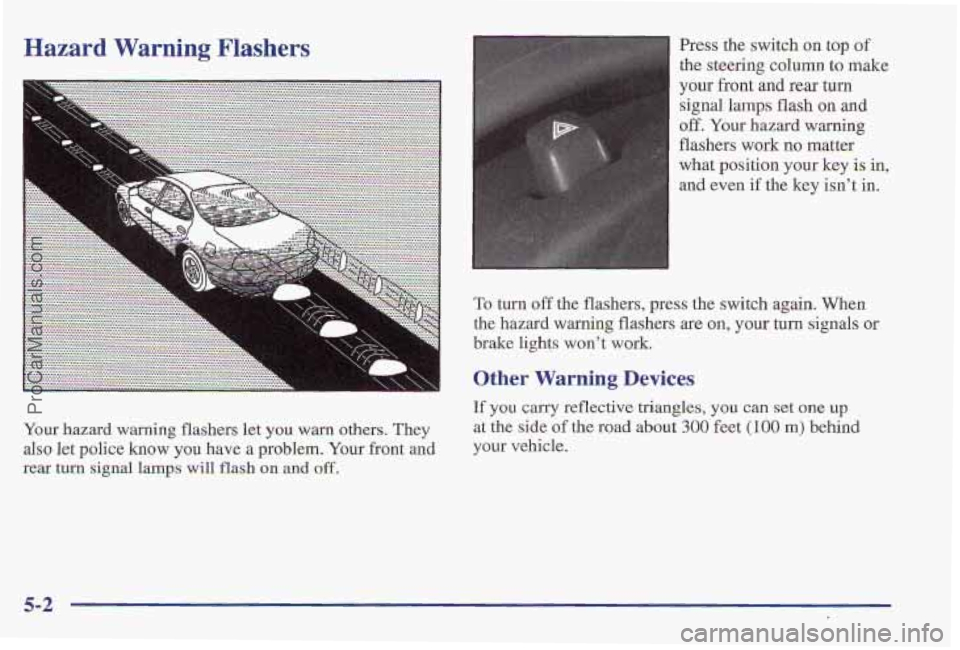
Hazard Warning Flashers Press the switch OB top of
the steering column to make
your front and
rear turn
signal lamps
flash on and
off. Your hazard warning
flashers
work no matter
what position your key
is in,
and even if the key isn’t in.
Your hazard warning flashers let you warn others. They
also let police know
you have a problem. Your front and
rear
turn signal lamps will flash on and off.
To turn off the flashers, press the switch again. When
the hazard warning flashers are
on, your turn signals or
brake lights won’t work.
Other Warning Devices
If you carry reflective triangles, you can set one up
at the side of the road about 300 feet (100 m) behind
your vehicle.
5-2
ProCarManuals.com
Page 251 of 419
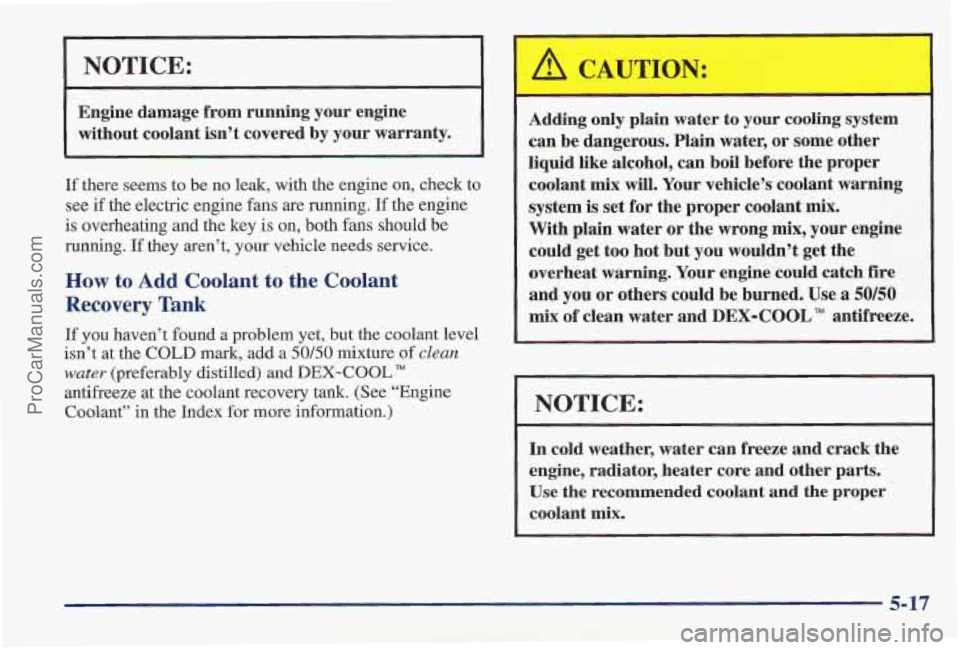
NOTICE:
Engine damage from running your engine
without coolant isn’t covered
by your warranty.
_I
If there seems to be no leak, with the engine on, check to
see if the electric engine fans are running.
If the engine
is overheating and the key
is on, both fans should be
running. If they aren’t, your vehicle needs service.
How to Add Coolant to the Coolant
Recovery Tank
If you haven’t found a problem yet, but the coolant level
isn’t at the
COLD mark, add a 50/50 mixture of clean
water (preferably distilled) and DEX-COOL
antifreeze at the coolant recovery tank. (See “Engine
Coolant” in the Index for more information.)
Adding only plain water to your cooling system
can be dangerous. Plain water, or some other
liquid like alcohol, can boil before the proper
coolant mix will. Your vehicle’s coolant warning
system is set for the proper coolant
mix.
With plain water or the wrong mix, your engine
could get too hot but you wouldn’t get the
overheat warning. Your engine could catch
fire
and you or others could be burned. Use a 50/50
mix of clean water and DEX-COOL antifreeze.
I NOTICE:
In cold weather, water can freeze and crack the
engine, radiator, heater core and other parts.
Use the recommended coolant and the proper
coolant mix.
ProCarManuals.com
Page 384 of 419
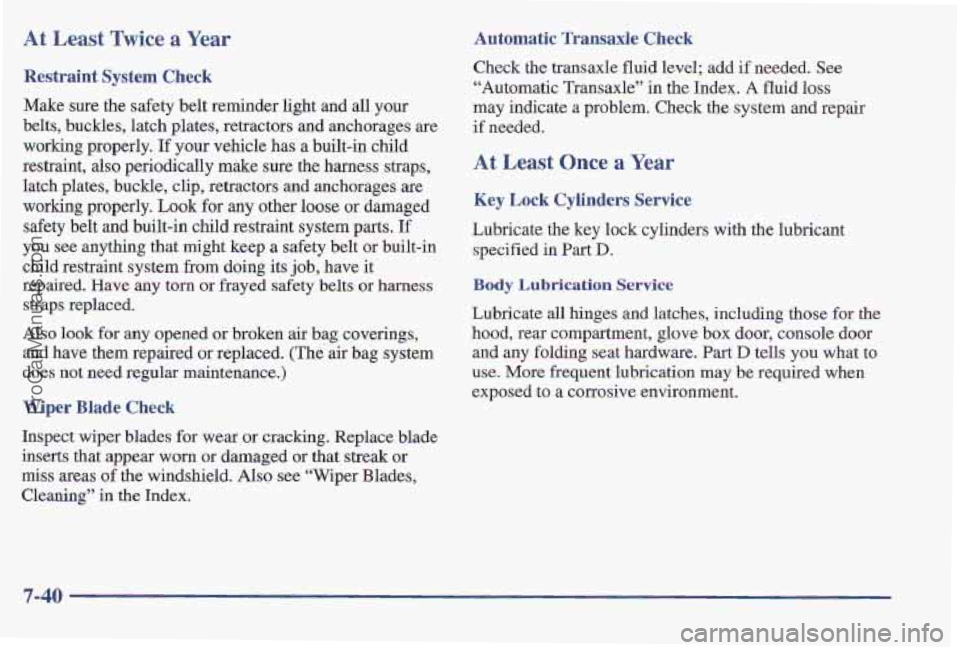
At Least Twice a Year
Restraint System Check
Make sure the safety belt reminder light and all your
belts, buckles, latch plates, retractors and anchorages are
working properly, If
your vehicle has a built-in child
restraint, also periodically make sure the harness straps,
latch plates, buckle, clip, retractors and anchorages are
working properly. Look for any other
loose or damaged
safety belt and built-in child restraint system
parts. If
you see anything that might keep a safety belt or built-in
child restraint system from doing its
job, have it
repaired. Have any torn or frayed safety belts or harness
straps replaced.
Also look for any opened or broken air bag co’verings,
and have them repaired or replaced,
(The’ air bag system
does
not need regular maintenance.)
Wiper Blade Check
Inspect wiper blades for wear or cracking. Replace blade
inserts that appear worn or damaged or that streak or
miss areas oftle windshield. Also see “Wiper Blades,
Cleaning”
in the Index.
Automatic Tkansaxle Check
Check the transaxle fluid level; add if needed. See
“Automatic Transaxle” in
the Index. A fluid loss
may indicate a problem. Check the system and repair
if needed.
At Least Once a Year
Key Lock Cylinders Service
Lubricate the key lock cylinders with the lubricant
specified in
Part D,
Body Lubrication Service
Lubricate all hinges and latches, including those for the
hood, rear compartment, glove box door, console door
and any folding
seat hardware, Part D tells you what to
use. More frequent lubrication may be required when
#exposed
to a! corrosive environment.
7-40
ProCarManuals.com
Page 385 of 419
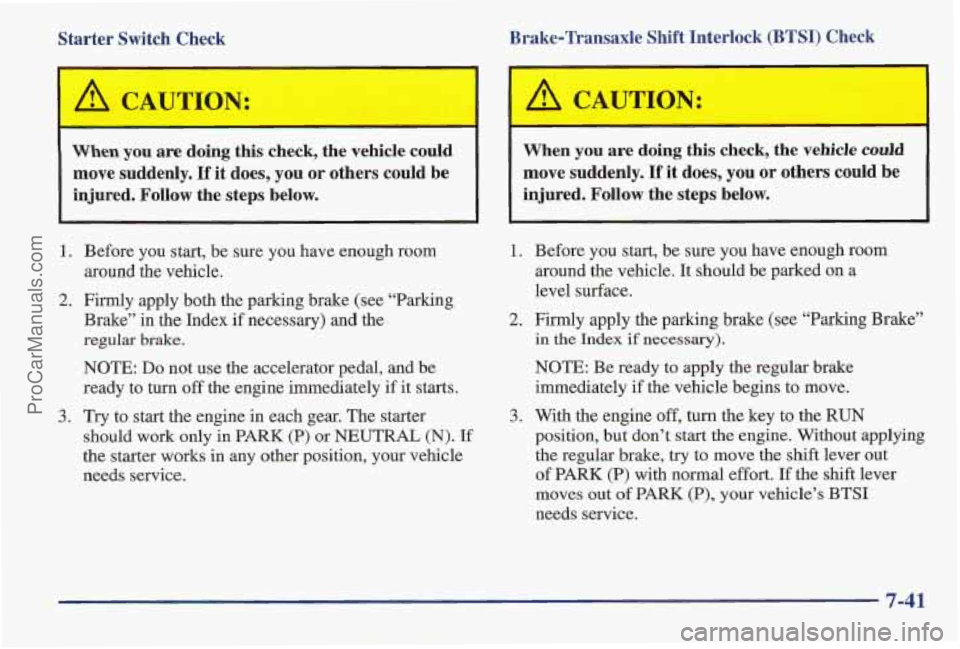
Starter Switch Check Brake-Transaxle Shift Interlock
(BTSI) Check
When you are doing this check, the vehicle could
move suddenly.
If it does, you or others could be
injured. Follow the steps below.
1. Before you start, be sure you have enough room
around the vehicle.
2. Firmly apply both the parking brake (see “Parking
Brake” in the Index
if necessary) and the
regular brake.
NOTE: Do not use the accelerator pedal, and be
ready to turn off the engine immediately
if it starts.
3. Try to start the engine in each gear. The starter
should work only in PARK
(9) or NEUTRAL (N). If
the starter works in any other position, your vehicle
needs service.
When you are doing this check, the vehicle could
move suddenly. If it does, you or others could be
injured. Follow the steps below.
1. Before you start, be sure you have enough room
around the vehicle. It
should be parked on a
level surface.
2. Firmly apply the parking brake (see “Parking Brake”
in the Index if necessary).
NOTE: Be ready to apply the regular brake
immediately if the vehicle begins to move.
3. With the engine off, turn the key to the RUN
position, but don’t start
the engine. Without applying
the regular brake,
try to move the shift lever out
of PARK (P) with normal effort. If the shift lever
moves out
of PARK (P), your vehicle’s BTSI
needs service.
7-41
ProCarManuals.com
Page 386 of 419

Ignition Transaxle Lock Check
While parked, and with the parking brake set, try to turn
the ignition key to LOCK in each shift lever position.
The key should turn to LOCK only when the shift
The key should come out only in LOCK.
lever is in PARK (P).
Parking Brake and Automatic Transaxle PARK (P)
MecT nism I-- leck
Park on a fairly steep hill, with the vehicle facing
downhill. Keeping your foot
on the regular brake, set the
parking brake,
To check the p,arking brake's holding ability: With
the engine running and transaxle in
NEUTRAL (N),
slowly remove foot pressure fiom the regular brake
pedal.
D'o this until the vehicle is held by the parking
brake only.
To check the PARK (P) mechanism's holding ability:
With
the engine running, shift to PARK (a). Then
release all brakes.
I
Underbody Flushing Service
When you are
d ng this check, your vehicle At least every spring, use plain water
to flush any
corrosive materials
from the underbody. Take care to could begin to move. You or others could be clean thoroughly any areas where mud and other debris
injured and property could be damaged. Make can collect.
sure there is room in front of your vehicle in case
it begins to roll. Be ready to apply the regular
brake at
once should the vehicle begin to move.
7-42
ProCarManuals.com
Page 388 of 419

Part D: Recommended Fluids
and Lubricants
NOTE: Fluids and lubricants identified below by name,
part number or specification may be obtained from your
GM dealer.
USAGE
Engine Oil
Engine Coolant
FLUIDLLUBRICANT
Engine oil with the American
Petroleum Institute Certified For Gasoline Engines “Starburst”
symbol of the proper viscosity. To
determine the preferred viscosity
for your vehicle’s engi lne, see
“Engine Oil” in the Index.
50/50 mixture of clean water
(preferably distilled) and use only
GM Goodwrench@ DEX-COOL TM
or Hawline@ DEX-COOL TM
coolant. See “Engine Coolant” in
the Index.
USAGE FLUIDLUBRICANT
System (GM Part No, 12377967 or
equivalent DOT-3 brake fluid).
Power Steering
(GM Part No. 1052884 - 1 pint,
System
GM Power Steering Fluid
105001 7 - 1 auart, or equivalent).
DEXRON@-111 Automatic
Transaxle Transmission Fluid.
I
Key Lock
Cylinders Multi-Purpose lubricant, Superlube@ (GM Part No. 12346241
or equivalent).
Supercharger Supercharger
Oil (GM Part
No. 12345982). See “Supercharges
Oil” in the Index.
7-44
ProCarManuals.com